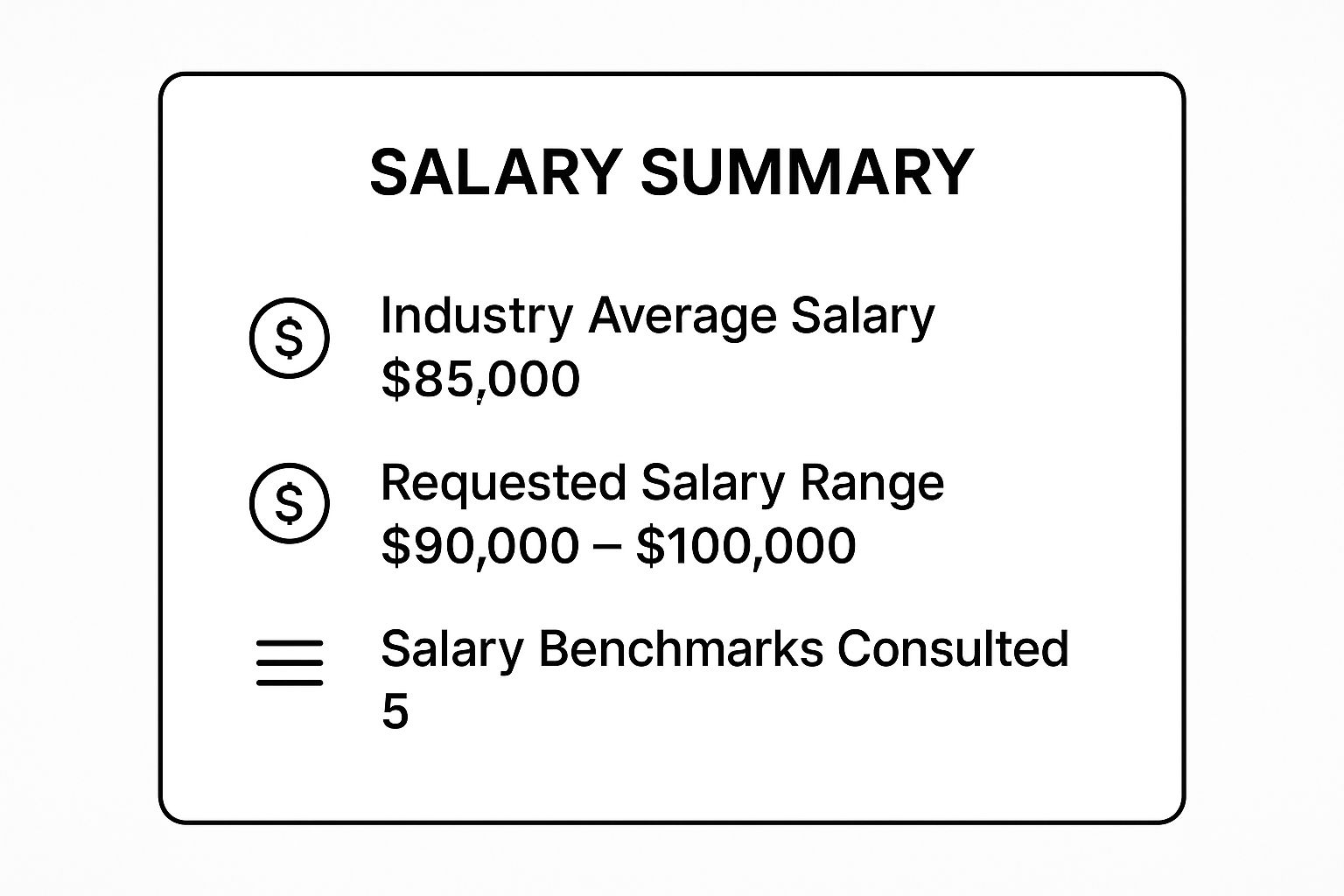You've received the job offer—congratulations! But before you accept, does the compensation package truly reflect your worth? Negotiating for a better salary, more benefits, or improved terms can feel intimidating, but a strategic counter offer letter is your most effective tool for success. It's not about being confrontational; it’s about clearly and confidently communicating your value and securing a position that meets your professional and financial goals.
This guide moves beyond generic advice to provide six detailed counter offer letter examples, each designed for a specific negotiation scenario. We will dissect the strategy behind every template, from focusing purely on salary to negotiating for better work-life balance or leveraging a competing offer. You'll gain actionable insights and adaptable frameworks to build a compelling case for yourself.
To effectively demonstrate your value, it helps to understand what truly influences decision-makers. Exploring powerful persuasive writing techniques can give you the edge you need to frame your request in the most convincing way. Our goal is simple: to equip you with the tools to turn a good job offer into a great one. Let's get started.
1. The Salary-Focused Counter Offer Letter
This is the most common type of counter offer, focusing squarely on increasing the proposed salary. Its power lies in using data, not just desire, to make a compelling case. You anchor your request in verifiable market rates and your own quantifiable achievements, transforming the negotiation from an emotional plea into a business discussion.
The goal is to demonstrate that your requested salary isn't just a random number; it's a reflection of your market value and the specific, measurable value you will bring to the company. This approach is direct, professional, and highly effective when backed by solid evidence.
When to Use This Approach
Use this counter offer letter example when the primary (or only) point of concern with the job offer is the base salary. It’s ideal for roles where performance can be easily quantified. For instance, a sales representative can point to exceeding quotas by a certain percentage, or a marketing manager can cite the exact ROI generated from their campaigns.
Strategic Breakdown
- Lead with Enthusiasm: Always start by reiterating your excitement for the role and the company. This frames the negotiation positively.
- Present Your Research: Clearly state the market rate for the position, citing reputable sources like Glassdoor, PayScale, or industry-specific salary reports. This shows you've done your homework.
- Connect to Your Value: Immediately follow up your market data with your own specific, quantified accomplishments. For example, "Industry reports show a salary range of $X to $Y for this role, which aligns with my experience in increasing lead generation by 35% in my previous position."
- Propose a Range: Suggesting a salary range (e.g., "$95,000 to $102,000") provides flexibility and signals that you're open to a discussion, rather than issuing a rigid demand.
The following visual summarizes the key data points you should gather before writing your salary-focused counter offer.

This data-driven approach positions your request as a well-researched, logical next step in the hiring process.
Actionable Takeaways
To make your salary-focused counter as effective as possible, be sure to gather strong evidence. Compiling this information is a crucial first step, and understanding how to structure it is equally important. For a deeper dive into formal letter writing, you can learn more about how to write a letter for any professional situation. Remember to close your letter by expressing your continued interest and suggesting a time to discuss the proposal further. This maintains momentum and keeps the conversation collaborative.
2. The Comprehensive Benefits Package Counter Offer
This holistic approach moves beyond a singular focus on salary to negotiate the entire compensation package. Its power comes from recognizing that total rewards include much more than just base pay, such as paid time off, remote work flexibility, and professional development funds.

The goal is to craft a role that aligns with your financial needs and supports your overall well-being and career growth. By presenting a multi-faceted request, you show the employer that you are thinking long-term about your contribution and integration into the company culture. This strategy frames your negotiation as a collaborative effort to build a mutually beneficial partnership.
When to Use This Approach
Use this type of counter offer letter example when the base salary is close to your target, but other aspects of the offer are lacking. It is perfect for situations where work-life balance, career development, or non-monetary perks are just as important to you as the salary figure. For example, a project manager might negotiate for flexible hours to manage family commitments, or a technical lead may prioritize equity options and a home office setup allowance.
Strategic Breakdown
- Open with Strong Interest: Begin by expressing genuine excitement and gratitude for the offer. This sets a positive and cooperative tone for the negotiation.
- Acknowledge the Offer's Strengths: Briefly mention what you like about the initial offer before introducing your proposed adjustments. This shows you've considered it carefully.
- Bundle Your Requests: Present your desired changes as a single, comprehensive package rather than a list of separate demands. For instance, "I would be thrilled to accept if we could adjust the total package to include a salary of $X, an additional week of vacation, and a professional development stipend."
- Justify the "Why": For each request, provide a brief rationale that connects it to your ability to perform better in the role. Frame a request for remote work options as a way to enhance focus and productivity.
The video below offers additional insights into negotiating for benefits beyond salary.
This comprehensive approach demonstrates that you're invested in finding a long-term fit with the company.
Actionable Takeaways
To execute this strategy effectively, you must prioritize your requests and be prepared to be flexible. Decide which benefits are "must-haves" and which are "nice-to-haves" before you write your letter. This preparation helps you navigate the discussion more effectively. For more guidance on structuring your arguments, you can explore resources on professional letter writing. Always end your letter by reaffirming your enthusiasm and suggesting a follow-up conversation, keeping the process moving forward collaboratively.
3. The Value-Demonstration Counter Offer Letter
This approach shifts the negotiation's focus from what the market pays to what you are uniquely worth. Instead of relying solely on external salary data, you build a powerful business case centered on your specific skills, quantifiable past achievements, and the direct, tangible value you will create for the new organization.
The goal is to frame your requested compensation not as a cost, but as an investment. You are demonstrating that your unique contributions will generate a return far exceeding the increase you are requesting. This is one of the most persuasive counter offer letter examples because it aligns your personal value directly with the company's goals, like increasing revenue, cutting costs, or improving efficiency.
When to Use This Approach
Use this strategy when your skills and accomplishments are exceptional or when you can directly link your past successes to the specific challenges and objectives of the new role. It is highly effective for positions where your impact is measurable. For example, a financial analyst can highlight cost-saving initiatives that generated millions, or an operations manager can point to process improvements that boosted efficiency by a significant percentage. This method also works well when negotiating for more than just salary, like performance bonuses or professional development opportunities.
Strategic Breakdown
- Open with Aligned Excitement: Start by expressing your enthusiasm for the role, specifically mentioning a company goal or project you are eager to contribute to.
- Build Your Value Proposition: This is the core of your letter. Use clear, concise bullet points to list your most relevant and quantifiable achievements. Frame them as direct evidence of the value you will deliver.
- Connect Past to Future: Explicitly state how your past wins will translate into future success for their company. For instance, "My experience in increasing user retention by 25% directly applies to your stated goal of reducing customer churn this quarter."
- Make a Confident Ask: Present your counter offer as a logical conclusion based on the evidence provided. Link your request back to the value you've just demonstrated, making it clear that the compensation reflects the results you are expected to deliver.
Actionable Takeaways
To execute this strategy, you must quantify your career highlights. Go through your resume and attach specific numbers, percentages, or dollar amounts to every accomplishment. For instance, instead of saying you "improved team efficiency," state that you "implemented a new workflow that reduced project completion time by 15%." This specificity is what makes the value-demonstration approach so compelling. Conclude your letter by reiterating your strong interest and proposing a discussion, reinforcing a collaborative and professional tone.
4. The Competing Offer Counter Letter
This approach leverages a tangible, competing job offer to strengthen your negotiating position. Its effectiveness comes from demonstrating your high market demand in a concrete way. You are not just asking for more based on research; you are showing that another company has already valued your skills at a specific, often higher, level.
The goal is to communicate this information tactfully, framing it as a point of data rather than an ultimatum. You are essentially saying, "I am very excited about your opportunity, but I have another compelling offer that I must consider. I would prefer to join your team if we can bridge this gap." This positions you as a sought-after candidate while affirming your genuine interest in their role.
When to Use This Approach
Use this counter offer letter example only when you have a legitimate, written offer from another company. It is particularly powerful when the offers are from comparable firms or when the competing offer has a significantly better compensation package. For example, a software developer might leverage a high-equity offer from a startup when negotiating with a more established tech company, expressing a preference for the latter's culture and stability.
This method requires honesty and confidence. Never bluff or invent a competing offer, as it can backfire and damage your professional reputation.
Strategic Breakdown
- Reaffirm Strong Interest: Begin by expressing your sincere enthusiasm for the role and company. This is crucial to show that your negotiation is not just about playing one company against another.
- Introduce the Competing Offer: Tactfully mention that you have received another offer. You don't need to name the company but should be prepared to share general details about the compensation or key benefits if asked. For instance, "After careful consideration, I am writing because I have also received a competitive offer with a base salary of $X."
- State Your Preference: Clearly state that their company is your first choice. This is the most critical part of the strategy. It changes the dynamic from a threat to a collaborative problem-solving discussion.
- Make a Specific Ask: Clearly articulate what it would take for you to accept their offer. This could be matching the salary, improving the benefits, or offering a specific perk like remote work flexibility.
Actionable Takeaways
To make this counter offer effective, your communication must be professional and transparent. A key part of this is handling the conversation with care and respect, regardless of the outcome. For a deeper understanding of the professional courtesies involved, you can review some best practices for letter writing etiquette and the dos and don'ts. Remember to close your letter by suggesting a conversation to discuss the details, reinforcing your desire to find a mutually beneficial agreement and join their team.
5. The Career Growth and Development Counter Offer
This type of counter offer shifts the negotiation from immediate salary to long-term value and professional growth. Its power comes from framing your requests as an investment in your future with the company, demonstrating a commitment that goes beyond the initial paycheck. You focus on opportunities for learning, skill enhancement, and a clear career path.
The goal is to show that you are motivated by professional advancement and want to grow with the organization. By asking for development resources like certifications, training, or mentorship, you signal that you are eager to contribute at a higher level, making you a more valuable asset over time. This approach is strategic, forward-thinking, and often well-received by employers who value ambitious talent.
When to Use This Approach
Use this type of counter offer letter example when the salary is close to your expectations but the role lacks a clear path for advancement or skill development. It is particularly effective for early to mid-career professionals eager to build their expertise. For example, a junior data scientist might request funding for a machine learning certification, or a marketing associate could ask for a budget for a digital marketing bootcamp and a structured mentorship program.
Strategic Breakdown
- Express Strong Commitment: Begin by reiterating your excitement and explicitly stating your desire to build a long-term career with the company.
- Propose Specific Opportunities: Don't just ask for "growth." Propose concrete development goals. For example, "I am eager to pursue the Project Management Professional (PMP) certification within the first year to better manage upcoming initiatives."
- Connect to Business Value: Clearly articulate how your professional development will directly benefit the company. Link your requested training to specific job responsibilities or future company goals, showing a clear return on their investment.
- Request a Clear Timeline: Ask for a structured promotion path or regular performance reviews tied to career progression. This demonstrates your ambition and asks the company to formalize its commitment to your growth.
This approach positions your counter offer as a collaborative plan for mutual success.
Actionable Takeaways
To make your career growth counter offer compelling, research the company's existing development programs and identify specific, relevant opportunities they could support. Connect your requests directly to the value you will bring to the team, framing it as an investment with a tangible ROI. It's also wise to ensure your professional aspirations are well-documented, which often begins with strong recommendations from previous roles. For more on this, you can learn about the crucial role of reference letters in your career. Conclude your letter by expressing your flexibility and eagerness to discuss how you can build a successful future together.
6. The Work-Life Balance Counter Offer Letter
This type of counter offer prioritizes non-monetary benefits that enhance work-life integration. Its power comes from framing flexibility not as a personal convenience, but as a strategic tool for maximizing productivity, engagement, and long-term commitment. It demonstrates a modern approach to work, showing the employer you are focused on sustainable high performance.

The goal is to present a well-reasoned plan that addresses potential employer concerns about communication and output. Instead of simply asking for time off, you are proposing a new, more efficient way of working that benefits both you and the company. This positions you as a forward-thinking and responsible professional.
When to Use This Approach
Use this counter offer letter example when the salary and core benefits are acceptable, but the standard work schedule poses a significant challenge. It is perfect for working parents needing to align their hours with school schedules, professionals seeking to reduce commute times with a hybrid model, or individuals in creative or project-based roles who work best with non-traditional hours. This approach is most successful in industries that have already embraced remote or flexible work.
Strategic Breakdown
- Start with Strong Alignment: Begin by enthusiastically accepting the role and reinforcing your alignment with the company’s mission and goals. This establishes a collaborative tone.
- Propose a Specific Plan: Clearly outline the exact arrangement you are requesting. For instance, instead of asking for "flexibility," propose a "hybrid schedule with remote work on Mondays, Wednesdays, and Fridays, and in-office collaboration on Tuesdays and Thursdays."
- Address Concerns Proactively: Acknowledge and mitigate potential concerns. Explain how you will maintain communication, collaborate with the team, and ensure your productivity remains high. Mentioning specific tools like Slack or Asana can be very effective.
- Suggest a Trial Period: Proposing a 60 or 90-day trial period can significantly lower the barrier to acceptance. This shows confidence in your ability to make the arrangement work and gives the employer a low-risk way to agree.
This proactive and solution-oriented method transforms your request from a simple ask into a business proposal, making it one of the most effective counter offer letter examples for today's workplace.
Actionable Takeaways
To build a compelling case, research the company’s existing flexible work policies and culture. If other employees have similar arrangements, it strengthens your position. When writing your letter, frame your request around mutual benefits like increased focus, reduced overhead, or greater employee retention. For more guidance on crafting professional correspondence, you can explore detailed resources on how to write a formal letter. Always end by reiterating your excitement and suggesting a brief call to discuss the logistics, keeping the process moving forward.
Counter Offer Letter Types Comparison
| Counter Offer Type | Implementation Complexity | Resource Requirements | Expected Outcomes | Ideal Use Cases | Key Advantages |
|---|---|---|---|---|---|
| The Salary-Focused Counter Offer Letter | Low | Moderate (salary data research) | Clear salary adjustment | Standard salary negotiations | Direct, data-driven, shows market awareness |
| The Comprehensive Benefits Package Counter Offer | High | High (research multiple benefits) | Enhanced total compensation package | Negotiations needing multi-faceted benefits | Broad appeal, long-term thinking, creative solutions |
| The Value-Demonstration Counter Offer Letter | Medium | Moderate to High (documentation) | Strong value justification | Experienced candidates emphasizing unique skills | Differentiates candidate, ROI focused |
| The Competing Offer Counter Letter | Medium | Low to Moderate (offer verification) | Increased leverage, faster decision | Candidates with multiple job offers | Strong negotiation power, urgency creation |
| The Career Growth and Development Counter Offer | Medium | Moderate (program research) | Structured advancement opportunities | Early to mid-career professionals | Demonstrates ambition, long-term commitment |
| The Work-Life Balance Counter Offer Letter | Low to Medium | Low to Moderate (policy research) | Improved flexibility and job satisfaction | Roles adaptable to flexible schedules | Aligns with modern priorities, cost-effective |
Final Thoughts: Secure Your Best Offer with Confidence
Navigating the job offer stage is more than just a final hurdle; it's your first opportunity to establish your value within a new organization. The counter offer letter examples we've explored throughout this guide are not just templates. They are strategic blueprints designed to empower you in this critical conversation.
By now, you've seen that a successful counter offer is built on a foundation of preparation, professionalism, and persuasive communication. It’s not about making demands, but about opening a collaborative dialogue to find a mutually beneficial middle ground. The most effective negotiations are those where both you and your future employer feel you've reached a positive outcome.
Key Strategic Pillars of a Strong Counter Offer
To distill the core lessons from our examples, remember these fundamental principles. Each counter offer letter, regardless of its specific focus, leveraged these pillars to build a compelling case.
- Data is Your Ally: The strongest arguments are backed by evidence. Whether you're referencing industry salary benchmarks, quantifiable achievements from your past roles, or the details of a competing offer, objective data removes subjectivity and strengthens your position.
- Value-Centric Language: Always frame your requests around the value you will deliver. Connect your desired salary to your unique skills, link your request for a better title to the leadership you will provide, and tie your need for professional development funds to the future innovations you will bring to the team.
- Professionalism is Non-Negotiable: Your tone sets the stage for the entire negotiation. Maintain a respectful, appreciative, and collaborative voice throughout your letter. This reinforces that you are a serious professional who is genuinely excited about the opportunity, not just the compensation.
From Examples to Action: Your Next Steps
Reading through these counter offer letter examples is the first step. Now, it’s time to put that knowledge into practice. Before you begin writing, take a moment to define your non-negotiables and your "nice-to-haves." Is a higher base salary your primary goal, or would a flexible work schedule and a better title create a more fulfilling long-term opportunity?
Once you have clarity on your priorities, select the example that most closely aligns with your situation. Use its structure as your guide, but customize the content to reflect your unique career story, your specific accomplishments, and your genuine enthusiasm for the role. Remember, authenticity is key. Your goal is to combine the proven strategies from these examples with your personal voice to create a letter that is both professional and powerful. This final, thoughtful step in your job search can significantly impact your career trajectory, financial well-being, and overall job satisfaction for years to come.
Ready to craft the perfect response but not sure where to start? The AI Letter Generator can help you create a polished and persuasive counter offer letter in seconds. Just provide your key negotiating points and desired tone, and our tool will generate a professional letter based on the successful strategies discussed here, empowering you to negotiate with confidence. Try the AI Letter Generator today!




